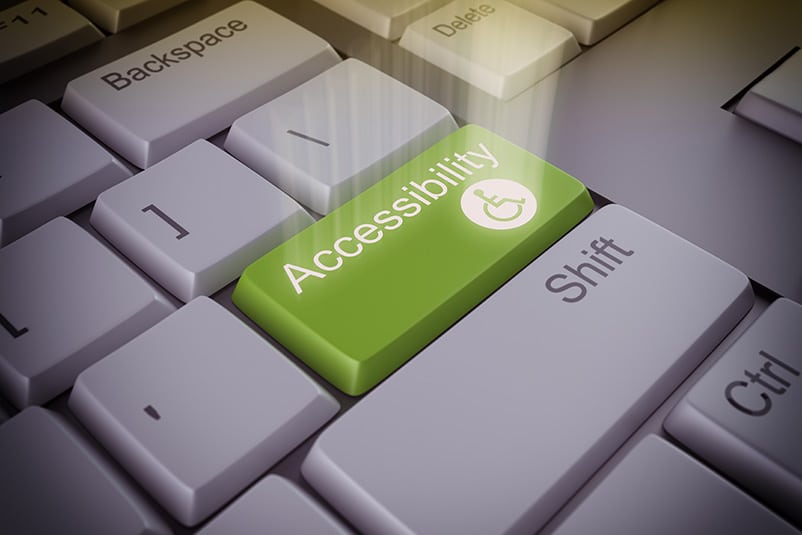This article was written by Aristotle Sangalang and originally published in the Spring 2019 edition of the RMAI Insights magazine, a biannual publication for, by, and about the receivables management industry. For more information about RMAI, please visit rmaintl.org.
As the integration of technology increases across the U.S. and the globe, the reciprocal demand for accessibility is multiplying. Once, brick and mortar businesses were the mainstays of our economy, but as consumers are more frequently turning to e-commerce and online banking, our society is rapidly building a digital economy. Consumers use the internet as their source of information, a shopping resource, and even as their financial hub. Therefore, it’s become critical to ensure that everyone, regardless of ability level, has access to online information. When the Americans with Disabilities Act was initially enacted, it expanded accessibility in our physical world, however, it is essential that we now broaden our digital world as well. Technology has become an integral part of our daily lives and the ability to effectively access online information is a key aspect of being not only an active member of our society but also a functional and responsible consumer.
What is ADA?
Originally, ADA, or the Americans with Disabilities Act of 1990, was a civil rights law passed to prevent discrimination of persons with a disability. Modeled after the Civil Rights Act of 1964 and Section 504 of the Rehabilitation Act of 1973, ADA sought to prohibit discrimination on the basis of disability. To be eligible for protection under ADA, an individual must have a disability, which is defined as either a physical or mental impairment that severely limits one or more major life activity. Protection under ADA can also include persons with a history of such impairments or persons who are perceived by others as having such impairments. Since its inception, ADA has expanded to include not only physical accessibility but online accessibility as well.
How does ADA Relate to Technology and Websites?
Technology has drastically changed not only how we do business, but also how we access information in our daily lives. The internet and the information it provides has the capability to enrich our lives and expand our world. In 1998, the U.S. Congress amended the Rehabilitation Act of 1973 to include Section 508, which required Federal agencies to make electronic and information technology available to persons with disabilities. As Title III of the Americans with Disabilities Act prohibits discrimination based on disability in activities of places of public accommodations, there have been no clearly defined laws regarding web accessibility. However, guidelines have been released which include standards that define how to make web content more accessible to those with disabilities. The most current version of the guidelines, known as the Web Content Accessibility Guidelines (WCAG) 2.1, were most recently updated on June 5, 2018, and extend the previous version, 2.0, which was published by the W3C (World Wide Web Consortium) in December 2008. WCAG has quickly become the ISO standard, and while not a legal obligation, businesses with an online presence should be cognizant of accessibility for users with disabilities. When designing websites with ADA accessibility in mind, guidelines identify that websites will be accessible to individuals identified as disabled and requiring adaptations in these areas:
- Visual (blindness, low-vision, color-blindness),
- Hearing (deafness and hard-of-hearing),
- Motor (inability to use a mouse, slow response time, limited fine motor control),
- Cognitive (learning disabilities, distractibility, inability to focus or remember large amounts of information)
Ultimately, accessibility is about the end user. As consumers are the heart of the accounts receivables management industry, it is strongly recommended that businesses consider the guidelines outlined in WCAG 2.1 and aim to focus web design around consumer accessibility.
What is WCAG 2.1?
While the standards ingrained within the principles of WCAG 2.1 delve deep into the minute details inside the compliance of web accessibility, the 4 main guiding principles of WCAG 2.1 are: Perceivable, Operable, Understandable, and Robust (also commonly known by the acronym POUR). These four principles lay the foundation for web inclusiveness that is centered around those identified as disabled under one of the main categories of disabilities and thus, require specific adaptations in the design of web content. Nested within the four principles of web accessibility are guidelines and success criteria with which to gauge the level of web accessibility.
The Four Principles of WCAG 2.1:
- Perceivable: It can’t be invisible to the user’s senses
- Operable: The user must be able to operate the interface
- Understandable: The content and/or the operation must not be beyond the user’s understanding
- Robust: As technologies advance, the users must be able to access the content
How ADA Impacts the Collections Industry
Just as the principles of accessibility revolve around the end user, so does the accounts receivable industry. Assisting consumers with fulfilling financial obligations can be complex. From understanding consumer preferences to providing varied communication options, it’s important for companies to understand consumer barriers to not only increase revenue and compliance but also to increase consumer satisfaction. Although we are still studying the effects of recent changes within ADA, our immediate interpretation is that while not a legal requirement at this time, now, more than ever, it’s imperative to thoughtfully examine the accessibility of online information. Committing to ADA web accessibility, without the legal requirement to do so, demonstrates a commitment to every consumer. Going above and beyond to meet every consumer’s need creates a meaningful connection to build loyalty through compassion, resulting in positive, consumer relationships.
Steps to Achieve Accessibility
While ADA Accessibility is not an insurmountable task, evolving standards and varying levels of compliance and accessibility do make web development more complex than what an average website design would normally require. ADA Accessibility does demand a level of understanding and a depth of knowledge that should be completed by an experienced team in order to provide consumers with a robust and compliant website that meets, at least, minimum accessibility standards.
About Aristotle Sangalang
Aristotle Sangalang is the President and Chief Compliance Officer of The Bureaus, Inc. His leadership and strong creative skills have made him an integral part of The Bureaus, Inc. since 1996. Mr. Sangalang manages the day to day operations of the Company and oversees all collections and compliance operations. Certified by the Receivables Management Association International as a Certified Receivables Compliance Professional (CRCP), he is also responsible for analyzing and valuing the acquisition and sales of distressed debt portfolios. The Bureaus, Inc. was founded in 1928 and is headquartered in Northbrook, Illinois.
About The Bureaus, Inc.
The Bureaus, Inc. is a master servicer for accounts receivable portfolios and certified by the Receivables Management Association International (RMAI) as a Certified Receivables Company (CRB). Using cutting edge technology, internally developed proprietary tools, and the vast expertise of its management team, The Bureaus, Inc. combines technological strategies with data mining capabilities to identify opportunities not usually found by other asset management firms. Founded in 1928, The Bureaus, Inc. is located in Northbrook, Illinois.



